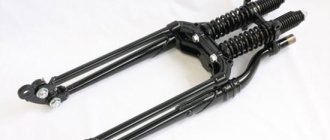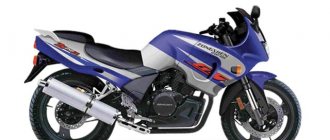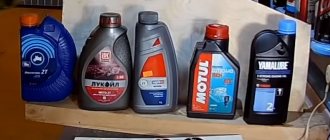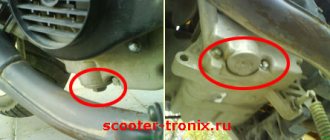Operating manual for Delta moped
Technical characteristics of the Delta moped
| engine's type | four-stroke, single-cylinder |
| Engine capacity | 49.0 cm³ |
| Maximum power | 3.5 hp |
| Cooling system | air |
| Engine starting method | kick starter and electric starter |
| Ignition system | CDI |
| Spark plug | NHDG1137 |
| Fuel | gasoline A-92, A-95 |
| Oil | 15W/40 |
| Maximum speed | 50 km/h |
| Fuel consumption | 1.61l/100 km |
| Fuel tank volume | 2.5 l |
| Weight | 65 kg |
| Maximum load | 80 kg |
| Transmission | mechanical |
| Brakes | Drum type |
| Tires (front/rear) | 2.25-17 |
| Dimensions (l/w/h) | 1800/700/970 mm |
| Seat height | 780 mm |
| Base | 1170 mm |
| Ground clearance | 105 mm |
| Battery | 12V/7Ah |
Moped device
The location of the moped elements and control handles is shown in Fig. 1-3
Fig 1.
1-Passenger footrest, 2-Electric starter, 3-Running footrest, 4-Rear brake pedal, 5-Frame number, 6-Trunk
Fig 2.
1-Seat, 2-Fuel valve, 3-Gear shift pedal, 4-Footrest, 5-Central step, 6-Side step, 7-Passenger step.
Fig 3
1-Headlight switch, 2-Instrument panel, 3-Light switch, 4-Front brake handle, 5-Throttle handle, 6-Ignition switch, 7-Horn button, 8-Turn signal switch, 9-Clutch handle, 10-Fuel tank cap.
Moped operating instructions
Engine starting
To start the engine when cold, turn the fuel valve to the “ON” position. Then insert the key into the ignition and turn to the “ON” position. Set the gear shift pedal to the neutral position. Close the choke on the carburetor and gently press the kick starter lever several times, and then start the engine with a sharp press.
Allow the engine to run for approximately 1-2 minutes and then return the choke to the open position. You cannot start driving with a not warmed up engine.
Starting a warm engine
Performed in the same sequence as when cold, but without closing the air damper. It is recommended to start a warm engine using an electric starter.
Start of movement
Depress the clutch lever and set the gear shift pedal to 1st speed. Slowly increase the engine speed, and at the same time smoothly release the clutch lever. The moped will start moving slowly. Increasing the engine speed, accelerate the moped, then, reducing the engine speed and squeezing the clutch lever, engage 2nd speed by pressing the front gear lever down. By repeating the procedure described above, you can switch to 3rd and then 4th gear. Choose the optimal speed depending on the situation on the road.
Braking
By turning the throttle control away from you, reduce the engine speed. Squeeze the clutch lever and simultaneously depress the front wheel brake lever and the rear wheel foot brake pedal with equal force. After stopping the moped, shift the gearbox to neutral, then release the clutch lever.
When braking a moped, use both brakes at the same time. By gradually increasing the force on the lever and brake pedal, you can ensure the most effective braking. Braking with only the front or rear wheel may cause the moped to skid or fall, so be extremely careful. When driving on wet or slippery asphalt, operate the braking system carefully and gently to prevent falling.
Stop
To stop the moped, turn the throttle control handle away from you to reduce the engine speed. Squeeze the clutch lever and simultaneously depress the front wheel brake lever and the rear wheel foot brake pedal with equal force. Shift the gearbox to neutral, then release the clutch lever. Turn off the engine. Place the moped on the kickstand.
Do not park the moped on a slope or soft ground to avoid it falling. To avoid burns, do not touch the hot exhaust pipe.
What kind of oil to pour into a delta moped. What kind of oil can be poured into an alpha moped?
To choose the right oil for a moped, consulting a salesperson in a store is not enough.
Moreover, many of them have only superficial knowledge of the characteristics and properties of motor oils. Motor oils should be selected depending on the engine installed on the motorcycle.
It should be remembered that in the regulatory and technical literature there is no special term “scooter oil”. However, in the store you often find oils specifically designed for motorcycle and moped engines. You can purchase them with confidence, paying attention only to what type of engine they are suitable for: two-stroke or four-stroke.
Or maybe it’s still a car?
The first thing that catches your eye when comparing car oil and motorcycle oil is the price. Motor oil is much more expensive than automobile oil.
According to manufacturers and many vehicle owners, motor oils spoil motorcycle components, and the clutch disappears.
But there is another opinion, according to which some conditionally negative impact actually happens. But this only applies to the clutch. And all the negativity comes down to the fact that modern oils have very strong cleaning properties, which simply lead to clutch slippage. But you can use less modern oil!
engine's type
When buying oil for a motorcycle, you need to pay attention to its classification, as well as the content of special additives.
To choose which oil to put into your scooter, first consider the engine type: products for two-stroke engines are not suitable for four-stroke engines, and vice versa. The fundamental difference in operation: oil for two-stroke engines is mixed with gasoline in a ratio of 1:25 or 1:50, depending on the manufacturer’s recommendation. Lubricant replacement in four-stroke engines occurs by draining the old product from the oil tank, washing and filling with a new one.
The choice between mineral, semi-synthetic or synthetic oil for mopeds and scooters is not difficult. For economy class mopeds and scooters, mineral or semi-synthetic is perfect. Mineral varieties are the cheapest, so they are more often purchased by poor scooter owners. But when using them, you should remember that they are chemically unstable, so the timing of their replacement must be strictly observed. Semi-synthetics are preferable to mineral ones, but are noticeably more expensive. Synthetic oil is intended for high-speed boosted scooters, whose engines place increased demands on oil quality. It preserves engine life better, has better viscosity, lower volatility, and a wider range of operating temperatures. For inexpensive mopeds, synthetics are just an unnecessary luxury.
Special attention should be paid: mixing mineral, semi-synthetic and synthetic oils is strictly prohibited!
Return to contents
Types of consumables
Semi-synthetic or mineral motor oil is also often used, since its cost is much lower. These materials are mainly used for engines that have high mileage. Since in this case the rubbing parts of the motor are already quite worn out, a more viscous lubricant is required. If you decide to replace the lubricant, then the old waste must be completely drained. After this, the engine needs to be rinsed thoroughly, and only then can new lubricant be added. Mixing different types of oils is not recommended. The same material must be added.
Quality Standards
Motor oils have various specifications indicating their quality: API, JACO and others.
The oil standard is indicated on the canister. After the letters API there is a letter designation of oil quality: from SA to SM. The S scale indicates that the oil belongs to gasoline engines; the quality scale is indicated by letters from A (low quality) to M (high quality). A total of 11 quality classes are provided: A, B, C, D, E, F, G, H, J, L and M. Products with specifications from SA to SE are currently almost never produced and are only suitable for older equipment manufactured in 80s or 90s. Modern mopeds and scooters consume oil of at least SF quality, but it is better if it is SH, SJ or SL.
Marking and viscosity
Engine wear is affected by the oil viscosity parameter
. The required viscosity depends on the operating temperature of the engine and is usually specified in the operating instructions. The generally accepted standard for designating viscosity according to the American SAE method: 5W40, 5W30, 10W40, 10W50 or simply SAE 40, SAE 50. Moreover, the first number indicates the viscosity of the oil in a cold engine, the second - in one warmed up to operating temperature. The letter W indicates that the oil belongs to winter or all-season varieties. Summer varieties do not have this letter and the first number (SAE 30, SAE 40). The lower the first number, the better the engine starts in cold weather. But if there is no need to ride a moped in winter, there is no point in using liquid oil. In warm weather, high viscosity provides better lubrication of power unit parts, the oil film on rubbing surfaces is not destroyed, and dry friction, overheating and destruction of parts are prevented.
For summer, viscosity 10W40, 10W50, SAE 30, SAE 40, etc. is more suitable. The higher the viscosity of the oil when hot (second number), the better suited the oil is for hot operating conditions. In mid-latitudes, SAE 30 or SAE 40 is quite suitable. In hot countries, SAE 50 and even SAE 60 are used.
Return to contents
Oil for four-stroke engines
In the main part of four-stroke engines (and the Alpha’s engine is four-stroke), oil is poured into the engine crankcase and does not lubricate the rubbing parts either by splashing (due to the introduction of rotating engine parts) or under pressure (which is done by the oil pump). Oil also helps cool the engine. What oil to fill in VAZ-2114 8 valves: choice. Therefore, the oil in a four-stroke engine must withstand a couple of years of operation at high temperatures.
Some owners ask: “Do I need to add oil to gasoline?” Alfa moped, replacing the air filter "Car" oil in a motorcycle. Remember: for Alpha mopeds (Delta, Sabur, Vento, etc.) there is no need to add oil to gasoline!
Gearbox oil
The annotation says what kind of oil should be poured into the engine, as annoying as it may sound, there is not a word about the gearbox. Although we are all accustomed to the fact that transmission oil is poured into the box, usually thicker than in the engine.
Owners of Alpha mopeds (not similar ones) should know that the gearbox, engine and clutch are located in the same (common) crankcase and are not lubricated with the same oil. What kind of oil to pour into the Mitsubishi Lancer 9 engine? – 2 answers Changing power steering oil Lancer 9. Thus, the worldview that what kind of oil should be poured into the wrong place would be incorrect. how much oil should be poured into the engine How much oil should be poured into the engine Yamz 238. There is only one!
Similar news
How often should you change the oil in your moped?
Choosing oil for the Hyundai Solaris engine The engine is the part of the car that especially needs lubrication. How to choose the right oil? After all, the assortment is so wide. Store shelves are practically lined with various canisters and not cans. What kind of oil should I put in Hyundai Solaris? There are two ways to answer this question. Option one. Here-.
What kind of oil to pour into the Alpha moped engine.
Many questions arise from people who are servicing a moped themselves for the first time.
The operating instructions require the use of oil for four-stroke engines, API SE, SF, viscosity SAE 15W40.
Let's try to figure out what this means.
SAE classification
The latest edition of the classification divides motor oils into 11 classes: 6 winter (0W, 5W, 10W, 15W, 20W, 25W) and 5 summer (20, 30, 40, 50, 60) viscosity classes. Letter W
(Winter) before the number means that the oil is adapted to work at low temperatures.
Most motor oils on the market today are all-season, i.e. they meet viscosity requirements at both low and high temperatures and have a double designation, for example in our case: SAE 15W-40
. how much oil should be poured into the YaMZ-236 engine. What kind of oil to fill in Renault The first number characterizes the pumpability of the oil at low temperatures. We choose which is better to fill the oil into the VAZ-2114 8-valve injection engine. If you subtract 35 from the first digit, you get the minimum temperature at which a safe cold start of the engine is possible. The second number is an indicator of oil viscosity at 100 degrees Celsius. If you add 5 to the second digit, you get the maximum permissible air temperature at which the oil can be used.
Similar news
Oil for four-stroke engines
This phrase means that you cannot fill the engine with 2-stroke engine. The fact is that two-stroke engines have a completely different principle of engine lubrication: they mix oil with gasoline in certain proportions (either in the gas tank or using a special oil pump), and then, together with gasoline, enter the engine crankcase, lubricating the crankshaft bearings and connecting rod, as well as a cylinder mirror. The mixture then enters the combustion chamber, where the oil burns along with gasoline and is removed from the engine through the exhaust pipe. In this case, two-stroke oil is not intended for long-term use.
, it's "disposable".
In most four-stroke engines (and the Alfa four-stroke engine), oil is poured into the crankcase and lubricates the cloth parts either by spray (due to the rotating parts of the engine) or under pressure (which creates an axial pump). In addition, the oil helps cool the engine. Therefore, the oil in a four-stroke engine must withstand a long service life at high temperatures.
Some owners ask: “Do I need to add oil to gasoline?” Remember: for Alpha mopeds (Delta, Sabur, Vento, etc.) you do not need to add oil to gasoline!
Oil for cars and motorcycles
When switching from a motorcycle to a car and vice versa, many people believe that the oil should be used differently in one and another equipment, since it works differently in it.
Three oils are used in a car:
- for the engine;
- for gearbox;
- for the rear axle.
In modern motorcycles on almost all models, all functions are carried out by one single oil, since the engine, gearbox, and clutch are located in one block.
They say that in cars, oil serves only as a protective barrier, preventing various mechanical stress. And in motorcycles, in addition, it must cool the engine and prevent thermal failure, since due to the huge rotation speed, a large amount of energy is produced, causing extreme heating.
Can I put car oil into an Alpha Delta moped?
If you want to make money on YouTube, then click here Help with the development of mine.
Next letter. oil generation symbol. The designation is in alphabetical order, that is, the further the letter is from the beginning of the Latin alphabet. that oil generation is higher (performance is better).
Currently, API categories API SA, SB, SC, SD, SE, SF, SG are considered invalid, category SH is considered conditionally valid. Therefore it is recommended in the instructions for moped categories SE
also
can’t find SF Then what oil should you buy? The answer is to buy any, following in alphabetical order (SJ, SL, SM, SN), it will in any case be no worse than the recommended one.
Synthetic, semi-synthetic or mineral water?
It is generally accepted that synthetic oils are of the highest quality and almost extend the life of the engine. On the other hand, as I wrote above, now any oil that has been certified in accordance with the API standard is suitable for use in the Alpha moped engine.
I have chosen a golden mean for myself: I introduce semi-synthetic imported manufacturers into the moped; The price of a liter of semi-synthetic oil is not much different from the price of petroleum products.
But only now it is rarely found on the shelves of semi-synthetic 15W-40. Mostly mineral oils are sold under this designation. Therefore, I fill the engine with 10W-40 oil as closest to the manufacturer's recommendations.
Myths about motorcycle oils.
Let's look at a few common beliefs and rumors about motorcycle oils that everyone has probably come across.
If you only drive long distances, you can change the oil less often.
Definitely, yes, since, as we have already understood, the oil suffers most from city driving and all kinds of stunt riding, when the engine experiences heavy loads during constant acceleration, and the clutch works almost constantly due to frequent gear changes. And on a long-distance trip you dialed it to cruising speed - and you throttle evenly and without shifting. Veterans confirm this idea, by the way. But just don’t get too carried away.
Motul conspiracy and counterfeit Motul.
There are two myths about motorcycle oil from one of the most famous manufacturers. The first myth about the Motul conspiracy is due to the fact that “no matter what motorcycle service I go to, they always fill me with Motul 7100 10W40.” Indeed, most often it is poured, although recently there have been exceptions. Of course, this is not a conspiracy, it’s just that, firstly, synthetic Motul 7100 can be poured, in most cases, anywhere, and it will go beyond the service area and continue to drive. A completely normal all-purpose oil for most motorcycles. And secondly, Motul is very easy to purchase in bulk, there are plenty of dealers, you don’t need to look for them, and the discounts for wholesale are decent. It is tritely profitable, but this is the law of the market, not a conspiracy.
In principle, I have never seen a scorched Motul in my life, although I have been involved in the motorcycle topic for ten years. Of course, I never bought 7100 in the back of garages, but, besides this, I want to note that it is much more difficult to fake Motul than any other colorless and odorless oil, at least because you also have to fake the color and smell! In addition, the label on their oil bottles changes quite often, and this is an additional factor that makes counterfeiting difficult.
Do not mix semi-synthetic and synthetic oil.
I mixed - the flight is normal! But I mixed different viscosities from the same manufacturer and was forced to do so. In general, the technical properties of Motul oils specifically indicate that the oil can be mixed with synthetic, mineral oils and semi-synthetics. In general, I think that in a forced situation it is possible to mix different motor oils, but I would not do this on purpose.
EVENTUALLY:
If you are using a motorcycle simply for traveling on public roads, do not be clever and fill it with any synthetic motorcycle oil from a reputable manufacturer. If you want to get smarter, use the automatic selection of engine oil, which almost every manufacturer now has on the official website. In both cases, just try to respect the service intervals.
If you ride racing or on motorcycles, then wise up!









